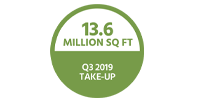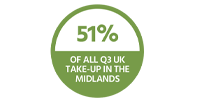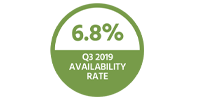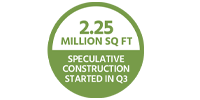PRIME LOGISTICS - Q3 2019
The definitive guide to the UK’s distribution property market.
STRONGEST TAKE-UP SINCE Q2 2018
Despite being the typically quieter summer period, the UK logistics property market delivered another strong set of results in Q3. Occupier demand was particularly strong, with the overall volume, buoyed by very large-scale commitments by automotive manufacturers and internet retailers.
Take-up of 13.6 million sq ft in Q3 marked a 7% quarterly increase and one of the strongest quarterly figures on our records. This is particularly encouraging given the current economic and political climate in the UK. However, the Q3 figure was inflated by Jaguar Land Rover’s 20 year pre-let at the 238 acre site at Appleby Magna, which received planning permission for 5 units totalling almost 3 million sq ft.
What is equally positive is that the quarterly take-up volume was above the 10-year average, even taking the JLR deal out of the figures. Other occupiers, including Amazon, Eddie Stobart and Urban Outfitters made large commitments to take space in Q3.
DEMAND FOR MIDLANDS SPACE DROVE TAKE-UP
Geographically, demand was squarely focused on the Midlands in Q3, with
6.9 million sq ft, or 51% of the Q3 volume agreed in the East and West Midlands. Whilst this is in large part due to the JLR deal, it is also reflective of how take-up continues to be driven by demand for new accommodation in core locations. Amazon, for instance, pre-let a 1.75 million sq ft facility in Sutton-in-Ashfield, and, IAC Group leased two speculatively-built buildings at Prologis Park in Birmingham.
It was perhaps unsurprising that the automotive manufacturing sector was the most acquisitive individual occupier type in Q3, due to both JLR and also commitments by some affiliated tenants in the dependant supply chain. However, other specific retail sub-sectors were also active in Q3. Fashion retail, for instance, had a strong quarter, as Puma and Urban Outfitters took space, as did dedicated internet retailers.
Internet retailers are now a mainstay of demand for logistics space. As the internet retail market itself has matured in the UK, so too has the type of internet retailer seeking logistics space. In Q3, we saw demand from heavyweights in the sector such as Ocado and Amazon, but also newer entrants to the market such as Super Smart Services, an ecommerce fulfilment specialist, which leased the M6DC building in Cannock from Exeter Property Group. The covenant strength of these new entrants is often less tested than the established internet retailers and landlords are adapting to how to effectively capture this new segment of demand.
Key statistics

13.6 Million Sq Ft taken up in Q3 2019

51% of all Q3 UK take-up in the midlands

6.8% Q3 availability rate

2.25 Million Sq Ft speculative construction started in Q3
AVAILABILITY RATE INCREASES FOR FOURTH CONSECUTIVE QUARTER
Following the addition of 1.8 million sq ft of available space in Q3, the overall UK logistics availability rate increased from 6.6% to 6.8%, the highest rate recorded since Q4 2014. This also marks the fourth consecutive quarterly increase in the UK availability rate.
Geographically, these increases in availability were in core locations with existing low rates – such as the Southern West Midlands, South Yorkshire and Merseyside & Cheshire. It was the addition of secondhand space to these markets which drove the volume of availability, especially in the West Midlands.
The development completion of speculatively-built buildings in Q3, which were subsequently added to ‘new’ availability, was also a driver of the increase in availability rate. Occupiers now have an enhanced quality of choice on offer and the new/refurbished availability rate rose from 3.9% to 4.3% in Q3, the highest since Q4 2012. However, despite these incremental quarterly increases, overall availability of all qualities of space remains low, with only around 55 million sq ft on the market.
VOLUME OF SPEC DEVELOPMENT HAS SLOWED IN 2019
Despite high levels of pre-let activity and development land purchases by occupiers over the last few years, we recorded more speculative space than purpose-built commencing construction in Q3. By volume, Q3 marked the fifth consecutive quarter where we recorded more speculative space getting underway than purpose-built.
This weighting towards speculative space in the development market is reflective of strong investor interest in the sector and the prevailing low availability. However, in absolute sq ft terms, the volume of speculative space starting construction has actually fallen each quarter this year from the high point in Q1 2019.
The potential impact of Brexit on occupier costs and supply chain configurations, together with rising availability in some markets, has made certain developers more cautious about starting schemes in Q3. As a result of some large-scale pre-lets agreed last year completing development in Q3 2019, it was a different story for development completions. Purpose-builds drove activity – accounting for 67% of all completions by volume as occupiers such as Wayfair, B&M Bargains and BSH Home Appliances completed on their facilities.
SUBDUED INVESTMENT, GIVEN LACK OF PORTFOLIO ACTIVITY
Overall investment in all UK industrial property (both multi-let and logistics) totalled £1.4 billion in Q3. When viewed on a rolling annual basis, investment volumes are subdued in comparison to previous years. A sharp reduction in portfolio activity this year has driven this decline, and, like most sectors, Brexit uncertainty is having an adverse effect, with fewer bidders on opportunities than this time last year.
In terms of specific warehouse investment in Q3, the volume traded increased by 11% on the quarter to £645 million, driven by such deals as Gazeley’s purchase of three units let to Eddie Stobart at Panattoni Park Northampton for £86.6 million. Market participants report of continued strong interest for ‘long and strong’ opportunities and there are several investors chasing prime, well-let long income opportunities.
We have also seen some new entrants to the market in Q3 drive inward movement in prime yields in some locations. Alpha Real Estate, for example, are new active purchasers and are setting yield benchmarks as they try to cement their position in the UK market against arguably more established bidders. However average transacted yields have moved out slightly in Q3 as some mid-income core-plus investments have not attracted the same level of interest.
Cookie Policy
Privacy Overview
| Cookie | Duration | Description |
|---|---|---|
| cookielawinfo-checkbox-analytics | 11 months | This cookie is set by GDPR Cookie Consent plugin. The cookie is used to store the user consent for the cookies in the category "Analytics". |
| cookielawinfo-checkbox-functional | 11 months | The cookie is set by GDPR cookie consent to record the user consent for the cookies in the category "Functional". |
| cookielawinfo-checkbox-necessary | 11 months | This cookie is set by GDPR Cookie Consent plugin. The cookies is used to store the user consent for the cookies in the category "Necessary". |
| cookielawinfo-checkbox-others | 11 months | This cookie is set by GDPR Cookie Consent plugin. The cookie is used to store the user consent for the cookies in the category "Other. |
| cookielawinfo-checkbox-performance | 11 months | This cookie is set by GDPR Cookie Consent plugin. The cookie is used to store the user consent for the cookies in the category "Performance". |
| viewed_cookie_policy | 11 months | The cookie is set by the GDPR Cookie Consent plugin and is used to store whether or not user has consented to the use of cookies. It does not store any personal data. |